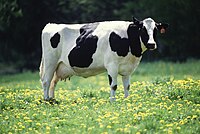
Photo from wikipedia
The objective of this study was to determine communication preferences of dairy producers in Canada. A secondary objective was to evaluate social media engagement of dairy producers. A survey was… Click to show full abstract
The objective of this study was to determine communication preferences of dairy producers in Canada. A secondary objective was to evaluate social media engagement of dairy producers. A survey was administered to Canadian dairy producers between March and April, 2015 to collect information on current management practices on their farms. A total of 1,373 Canadian dairy producers responded to the survey, representing a response rate of 12%. The survey consisted of 192 questions; however, only questions regarding producer demographics, importance of information sources, and internet and social media use were evaluated in this study. The primary outcome variables of interest included use of the internet to access dairy information, importance of different sources of information about dairy herd health and management, and use of online search engines and social media platforms. For each outcome, logistic regression analyses were used to investigate associations between the outcome and demographic variables. Veterinarians were viewed as a "very important" source of information by the majority of respondents (79%), whereas milk recording and dairy producer organizations were viewed as a "very important" source of information by 36% of respondents. Other producers (46%) and magazines or newspapers (51%) were commonly viewed as an "important" source of information. Online search engines were commonly used by respondents (94%). Social media was viewed as less important, and had mixed levels of use. YouTube (70%), Facebook (63%), and Twitter (18%) were the most commonly used social media platforms. Eighty percent of Twitter users reported using the platform to interact with and obtain or share information about herd health management online, which was the highest reported interactivy regarding herd health among all social media platforms. This exploratory study offers insight into the communication preferences of Canadian dairy producers and can be used to facilitate future communication strategies aimed at engaging rural farming audiences across Canada.
Journal Title: Journal of dairy science
Year Published: 2020
Link to full text (if available)
Share on Social Media: Sign Up to like & get
recommendations!